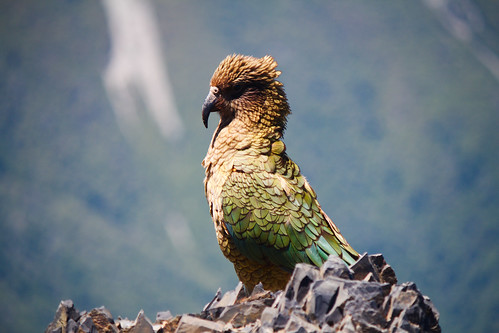Drop in kea numbers concern
 Wednesday, January 15, 2014 at 23:37
Wednesday, January 15, 2014 at 23:37  Kea are suffering from predation by introduced predators. Image by Florin Chelaru.Kea numbers in Kahurangi National Park are in sharp decline due to unchecked predators, a conservation group say.
Kea are suffering from predation by introduced predators. Image by Florin Chelaru.Kea numbers in Kahurangi National Park are in sharp decline due to unchecked predators, a conservation group say.
Kea Conservation Trust has returned from monitoring the endangered bird in the park around the Kiwi Saddle, where experts and volunteers were stationed from January 4 until 13. This was the third year they had visited the park. They capture and attach transmitters to kea where possible, and check band numbers.
Kea are unique to the South Island, with total population estimates below 5000.
Conservationist Corey Mosen led the team in Kahurangi and said they positioned themselves just above the tree line so they could see and hear the kea. Teams battled high winds, rain and cold temperatures to survey the kea.
Trust chair Tamsin Orr-Walker said they found population numbers of the endangered mountain parrot in decline, with no sighting of fledglings over the past two summer surveys.
Ms Orr-Walker said the population numbers were dependent on pest control - their chicks and eggs were preyed on by stoats, possums and rats. On this trip they recorded footage of a rat taking a kea egg.
They had seen six individual adult kea in this survey, and attached transmitters to two. In 2012, when they started monitoring the area, they caught five kea and attached two transmitters. Four fledglings were produced in the area during the 2011 nest season and all were caught up and transmitters attached. During 2012 they found two active nests, though one was lost to predators while the other fledged two chicks.
This time last year the survey only caught one kea, which they had seen from prior years and they did not find any new fledglings produced.
Ms Orr-Walker said the area needed "really intensive methods of pest control" to increase the population numbers.
They had surveyed both pest controlled and non-controlled parks and areas where kea nest, including the Nelson Lakes.
"In areas where 1080, or any other really intense method of pest control is used we are getting higher than 98 per cent nesting success - so at least one chick. It is less than the 2 per cent when an area is unmanaged."
She said areas where stoat trapping was used had proved effective as well.
She was particularly concerned with trees in the park fruiting, which would attract stoats, which kill the kea.
The kea would also eat the 1080 poison, so the trust said it needed to weigh up the controversial poison's benefits to harm caused. Likewise, ground traps were an issue.
Human activity also affected kea population numbers, from kea being poisoned from gnawing on buildings with lead paint, to threats of irate people shooting them.
"There's so many threats to them, more needs to be done to support them or they are stuffed," Ms Orr-Walker said.
"Tourists come here especially to see them, they are absolutely unique in the animal kingdom. People still think there are heaps around and that they are malicious but they are just being kea, they are inquisitive and like having fun."
The trust had relocated kea before due to threats from people shooting them. She said they were now trying to get communities to protect the kea. Ms Orr-Walker encouraged people who had issues with kea to contact the trust which would attempt to resolve problems.
 Nestor notabilis - Kea | in
Nestor notabilis - Kea | in  Conservation,
Conservation,  Introduced predators
Introduced predators 
